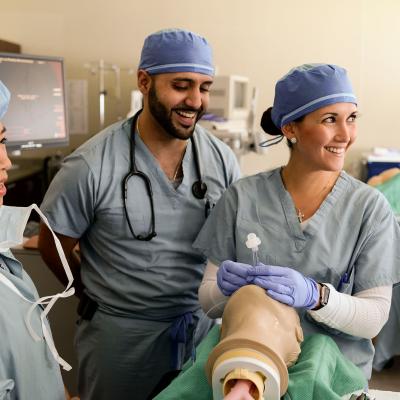- AdventHealth University

October is Breast Cancer Awareness month, an annual campaign that aims to raise awareness about the disease and to raise money for research targeted at finding a cure and preventing breast cancer. According to the Centers for Disease Control and Prevention (CDC), with the exception of some skin cancers, breast cancer is the most common type of cancer in women, regardless of ethnicity or race1. Although breast cancer is most common in women over age 50, about 11 percent of cases occur in females under the age of 452.
Early detection and treatment are key to beating breast cancer. If the cancer is caught in the earliest stages, the survival rate five years after diagnosis is nearly 100 percent and the survival rate five years after diagnosis for women with stage II cancer is around 93 percent3. Knowing the risk factors and signs of breast cancer and speaking with your doctor about screenings can help you detect cancer early and increase survival rate.
During Breast Cancer Awareness Month (and after), here’s what you can do to join the fight against breast cancer.
1. Learn About the Risk Factors for Breast Cancer
You can divide the risk factors for breast cancer into two categories. The first category is lifestyle risk factors, and these are the factors that you have control over and can change. These lifestyle risk factors include: not being physically active, being overweight, drinking more than one alcoholic drink per day, and using certain hormone-based medications, such as birth control pills or hormone-replacement therapy4.
If you are concerned about lifestyle risk factors, speak with your doctor about the things you can change to reduce your risk for cancer. Remember, these are the factors you can control! So, whether its replacing after work drinks with after work workout classes or talking to your doctor about alternative birth control methods, these are small changes that can help cut down your risk.
The second category is risk factors that you can’t change. These include your age, your genes, and family history of cancer. For example, most breast cancers in females are diagnosed after the age of 50, only a small percentage occur under the age of 45. All women have BRCA1 and BRCA2 genes, but certain mutations in the BRCA genes make cells more likely to divide and that increases your chance for not only breast cancer but also ovarian cancer.
Remember that having certain risk factors for breast cancer doesn’t mean you will get breast cancer. It just means that it’s a good idea to work with your doctor to set up a plan for screening and early detection.
2. Recognize the Signs and Symptoms of Breast Cancer
All women, regardless of age, race, and risk factors should know the signs of breast cancer.
A lump in one of the breasts is a symptom most commonly associated with cancer, but not all lumps are cancerous and not every woman with cancer develops lumps. Others signs to keep an eye out for are changes in the size or shape of the breasts, pain in the breasts, change in the appearance of the nipples or skin on the breasts, and non-milk nipple discharge.
Knowing what your breasts feel and look like today allows you to detect any changes in the future quickly. If you do notice any changes in your breasts, get in touch with your doctor right away and schedule a visit and potential screening.
3. Share Your Breast Cancer Story
Breast Cancer Awareness Month is the perfect time for you to share your breast cancer story, it can provide solace to yourself and offer hope to others. Whether you are a survivor of breast cancer or the loved one of someone who has breast cancer, by sharing your experiences, you can help others who might be going through the same thing. By telling your story you serve as both an inspiration and resource to someone else, letting them to know what to expect and know that there is hope at the end of this scary journey.
There are multiple ways you can get your story out there. Get social. Create a video or curate a post to share on your social media profiles. Check to see if there are events near your area that provide the opportunity to speak and share. If there is a breast cancer awareness event happening near you this month, you can ask the organizers if you can get up on stage and speak. Pick an online platform to share your story. For example, find a user generated community forum or website such as the American Cancer Society, that allows you to submit your story as one of their Stories of Hope.
4. Set Up a Fundraiser
One of the goals of Breast Cancer Awareness Month is to raise money for organizations that fund breast cancer research and treatment. You can do your part to help fundraise by signing up for or setting up an event or donation drive.
When it comes to raising the money, your options are limitless. You can host a bake sale at work or school, participate in a run or walk, set up a GoFundMe page, or create a challenge (such as if you raise $XX amount, you’ll wear a silly costume to work).
5. Talk to Your Doctor About Breast Cancer Screenings
Since there is no way to prevent breast cancer 100 percent, the key to increasing survival is early detection. Knowing what’s “normal” for your breasts can help you detect if anything’s amiss sooner rather than later.
To help with early detection make sure to schedule an annual well-woman visit with your doctor, which includes a breast examination and talk to your doctor about breast cancer screenings, such as mammograms. Mammograms are recommended every two years for women between the ages of 50 and 746. Mammograms can be recommended for younger women; your doctor can help you determine the best age to start getting this type of breast cancer screening.
AHU Online wants to see you succeed in your academic, personal, and professional lives. Learn more about our programs today.
Sources:
- “Breast Cancer Statistics,” Centers for Disease Control and Prevention, last modified June 11, 2018, https://www.cdc.gov/cancer/breast/statistics/index.htm.
- “Breast Cancer in Young Women,” Centers for Disease Control and Prevention, last modified June 18, 2018, https://www.cdc.gov/cancer/breast/young_women/index.htm/.
- “Breast Cancer Survival Rates,” American Cancer Society, last modified December 20, 2017, https://www.cancer.org/cancer/breast-cancer/understanding-a-breast-cancer-diagnosis/breast-cancer-survival-rates.html.
- “Lifestyle-related Breast Cancer Risk Factors,” American Cancer Society, last modified September 6, 2017, https://www.cancer.org/cancer/breast-cancer/risk-and-prevention/lifestyle-related-breast-cancer-risk-factors.html.
- “What Are the Risk Factors for Breast Cancer?,” Centers for Disease Control and Prevention, last modified September 11, 2018, https://www.cdc.gov/cancer/breast/basic_info/risk_factors.htm
- “What is Breast Cancer Screening?,” Centers for Disease Control and Prevention, last modified September 11, 2018, https://www.cdc.gov/cancer/breast/basic_info/screening.htm


